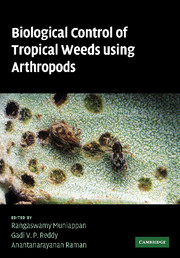Book contents
- Frontmatter
- Contents
- List of contributors
- Acknowledgments
- 1 Biological control of weeds in the tropics and sustainability
- 2 Acacia nilotica ssp. indica (L.) Willd. ex Del. (Mimosaceae)
- 3 Australian Acacia species (Mimosaceae) in South Africa
- 4 Ageratina adenophora (Sprengel) King and Robinson (Asteraceae)
- 5 Azolla filiculoides Lamarck (Azollaceae)
- 6 Cabomba caroliniana Gray (Cabombaceae)
- 7 Invasive cactus species (Cactaceae)
- 8 Chromolaena odorata (L.) King and Robinson (Asteraceae)
- 9 Clidemia hirta (L.) D. Don (Melastomataceae)
- 10 Coccinia grandis (L.) Voigt (Cucurbitaceae)
- 11 Eichhornia crassipes (Mart.) Solms–Laub. (Pontederiaceae)
- 12 Lantana camara Linn. (Verbenaceae)
- 13 Mimosa diplotricha C. Wright ex Sauvalle (Mimosaceae)
- 14 Mimosa pigra L. (Leguminosae)
- 15 Parthenium hysterophorus L. (Asteraceae)
- 16 Passiflora mollissima (HBK) Bailey (Passifloraceae)
- 17 Pistia stratiotes L. (Araceae)
- 18 Prosopis species (Leguminosae)
- 19 Salvinia molesta D. S. Mitchell (Salviniaceae)
- 20 Solanum mauritianum Scopoli (Solanaceae)
- 21 Application of natural antagonists including arthropods to resist weedy Striga (Oranbanchaceae) in tropical agroecosystems
- 22 Biological control of weeds in India
- 23 The role of International Institute of Tropical Agriculture in biological control of weeds
- 24 The role of Secretariat of the Pacific Community in the biological control of weeds in the Pacific Islands region – past, present, and future activities
- Index
18 - Prosopis species (Leguminosae)
Published online by Cambridge University Press: 04 August 2010
- Frontmatter
- Contents
- List of contributors
- Acknowledgments
- 1 Biological control of weeds in the tropics and sustainability
- 2 Acacia nilotica ssp. indica (L.) Willd. ex Del. (Mimosaceae)
- 3 Australian Acacia species (Mimosaceae) in South Africa
- 4 Ageratina adenophora (Sprengel) King and Robinson (Asteraceae)
- 5 Azolla filiculoides Lamarck (Azollaceae)
- 6 Cabomba caroliniana Gray (Cabombaceae)
- 7 Invasive cactus species (Cactaceae)
- 8 Chromolaena odorata (L.) King and Robinson (Asteraceae)
- 9 Clidemia hirta (L.) D. Don (Melastomataceae)
- 10 Coccinia grandis (L.) Voigt (Cucurbitaceae)
- 11 Eichhornia crassipes (Mart.) Solms–Laub. (Pontederiaceae)
- 12 Lantana camara Linn. (Verbenaceae)
- 13 Mimosa diplotricha C. Wright ex Sauvalle (Mimosaceae)
- 14 Mimosa pigra L. (Leguminosae)
- 15 Parthenium hysterophorus L. (Asteraceae)
- 16 Passiflora mollissima (HBK) Bailey (Passifloraceae)
- 17 Pistia stratiotes L. (Araceae)
- 18 Prosopis species (Leguminosae)
- 19 Salvinia molesta D. S. Mitchell (Salviniaceae)
- 20 Solanum mauritianum Scopoli (Solanaceae)
- 21 Application of natural antagonists including arthropods to resist weedy Striga (Oranbanchaceae) in tropical agroecosystems
- 22 Biological control of weeds in India
- 23 The role of International Institute of Tropical Agriculture in biological control of weeds
- 24 The role of Secretariat of the Pacific Community in the biological control of weeds in the Pacific Islands region – past, present, and future activities
- Index
Summary
Introduction
The taxon Prosopis (Leguminosae, mesquite) includes some of the most common tree species in the dry tropics (Pasiecznik et al., 2004). Several species, all of American origin, have been intentionally distributed throughout the tropical world, because of their acclaimed roles as fast-growing, drought-tolerant, multipurpose trees. They are valued as a rehabilitation tool for degraded rangelands, shade, fodder (the pods are palatable for livestock and humans), honey, charcoal, timber, fuel, and several other resources (Fagg and Stewart, 1994; Felker and Moss, 1996; Pasiecznik et al., 2001). Large-scale systematic plantings have been made in parts of Africa, several oceanic islands, the Middle East and the Indian subcontinent since the mid 1900s, but ad hoc introductions have been common since the early nineteenth century (Harding, 1988; Fagg and Stewart, 1994; Felker and Moss, 1996; Tewari et al., 1998; Pasiecznik et al., 2001; van Klinken and Campbell, 2001; Mauremootoo, 2006; Ogutu and Mauremootoo, 2006).
Introduced mesquite species have become invasive in many countries, while some species are a nuisance to humans and livestock within their native ranges (DeLoach, 1985; Dussart et al., 1998). As a result, mesquite is now seen to be causing substantial negative economic, environmental, and social impacts over large parts of the world (van Klinken and Campbell, 2001; Mauremootoo, 2006; Ogutu and Mauremootoo, 2006; Zimmermann et al., 2006). However, indications are that the per capita impacts of invasive populations could be greater in their exotic ranges.
- Type
- Chapter
- Information
- Biological Control of Tropical Weeds Using Arthropods , pp. 353 - 377Publisher: Cambridge University PressPrint publication year: 2009
- 8
- Cited by

